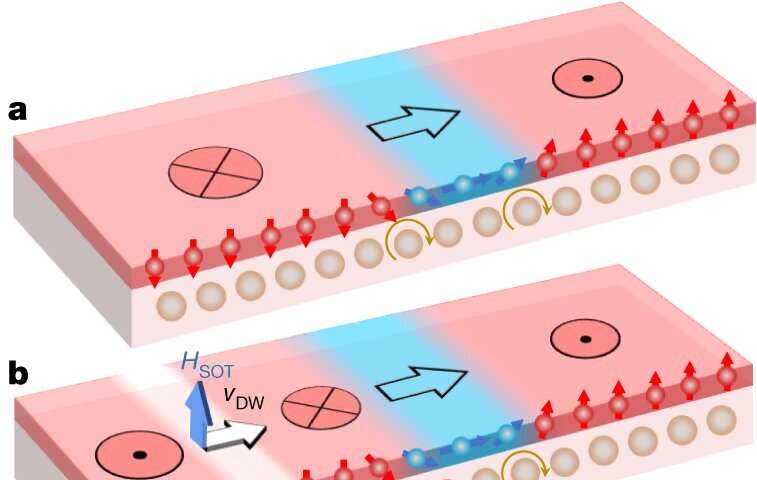Chiral coupling between adjacent nanomagnets and current-driven DW inversion. Credit: Nature (2020). DOI: 10.1038/s41586-020-2061-y
A team of researchers from ETH Zurich and the Paul Scherrer Institute has developed a way to build an all-electric magnetic logic gate. In their paper published in the journal Nature, the group describes their device and how well it works. See-Hun Yang with IBM Research–Almaden has published a News and Views piece outlining the work by the team in Switzerland in the same journal issue.
Over the past several decades, computers have grown ever faster, allowing for the vast suite of advanced applications that are now available to users. In order to see similar growth in the future, new methods for building computers will have to be developed, however. This is because the physical limits of silicon microcircuitry design are approaching. One interesting possibility to researchers is using magnetic elements in logic gates instead of the standard electronics now in use. Unfortunately, research on such elements has been held up by the need for external magnetic fields. In this new effort, the researchers have made inroads toward solving this problem by harnessing chirality between domains.
The work builds on the idea of magnetic racetrack memory, in which wires are moved by flowing electrons. They built a NOT logic gate that reverses the direction of magnetic domains using electricity. The gate consisted of a flattened, unmagnetized platinum wire covered with a layer of magnetized cobalt. In their arrangement, the magnetism in the cobalt was perpendicular to the wire, except in the fixed domain wall (the boundary between magnetized areas of the wire). And in the fixed domain, magnetism was allowed to rotate either left or right (chirality). When electricity was applied to one end of the wire on the platinum base, the moving domain wall was pushed along the wire. When it collided with another fixed wall, the direction of the magnetic force (moment) was switched, and a new domain with a reversed moment was created on the opposite side of the wall. The result was a flipped bit.
The researchers tested their gate by adding it to a junction, allowing for the creation of NOR and NAND gates. The researchers suggest their device could be a first step toward the development of a logic gate for commercial products without the need for any external magnetic fields. They suggest the next step will be to reduce the amount of current, followed by a better means of detecting the input/output states of the gate.
More information: Zhaochu Luo et al. Current-driven magnetic domain-wall logic, Nature (2020). DOI: 10.1038/s41586-020-2061-y
See-Hun Yang. An all-electrical magnetic logic gate that harnesses chirality between domains, Nature (2020). DOI: 10.1038/d41586-020-00635-y
Journal information: Nature
© 2020 Science X Network
























